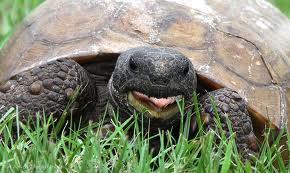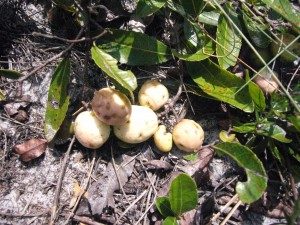If you like the taste of pink bubble gum, you’ll like gopher apples, if you can find them
Why can’t you find them? Because nearly every woodland creature likes them as well, from tortoise to teenager. I identified the plant some 15 years before I saw a good crop of fruit. They fly off the leafy shelves, as it were
In all fairness, authors tend to be divided about the flavor and fragrance of the gopher apples. Some say they are odorless and flavorless. Other say they smell like a new, plastic shower curtain. To me, and other foragers, they taste just like old fashion, pink, baseball bubble gum, and have sweet and fragrant. There is also a hint of almond flavor in there as well. I cannot explain the difference in perceptions. It either has to be a plant problem or a taste issue, or both. The texture, however, is quite different from bubble gum. The dirty white or pink ripe fruit is very soft with a resistance similar to watery custard. You really can’t carry them in your pocket too far. It has one large seed about an inch long that has been likened to an olive pit which I think is stretching the definition a little. You’ll find gopher apples growing from Florida north to South Carolina and west to Louisiana. Here in central Florida they are common site on the Seminole Bike Trail in Longwood and Lake Mary. In Melbourne they are directly behind (south) the doggie showers at the dog park inside Wickham Park.
 The plant, scientifically, is called Licania Michauxii, (lye-KAY-nee-uh miss-SHOW-ee-eye) and was named for the French botanist André Michaux, who might be that fellow to the right. The problem is father and son had similar names and both were botanists. Writers get them mixed up often. An early photograph identified as the elder Michaux has to be the son because the elder Michaux died 20 years before photography. The painting at the right could be the Younger or the Older. Judging by the handwriting my guess is it is the younger Michaux when he was younger. If you want to see him when he was older read my Maple Manna article. Anyway, the elder Michaux, personal botanist to King Louis XVI, traveled to the United States in the late 1700’s and described this plant in his journal (good thing is wasn’t witch hazel or we’d have “witch michauxii” not too easy to say.)
The plant, scientifically, is called Licania Michauxii, (lye-KAY-nee-uh miss-SHOW-ee-eye) and was named for the French botanist André Michaux, who might be that fellow to the right. The problem is father and son had similar names and both were botanists. Writers get them mixed up often. An early photograph identified as the elder Michaux has to be the son because the elder Michaux died 20 years before photography. The painting at the right could be the Younger or the Older. Judging by the handwriting my guess is it is the younger Michaux when he was younger. If you want to see him when he was older read my Maple Manna article. Anyway, the elder Michaux, personal botanist to King Louis XVI, traveled to the United States in the late 1700’s and described this plant in his journal (good thing is wasn’t witch hazel or we’d have “witch michauxii” not too easy to say.)
Licania is almost an anagram of what the Amazon natives called the plant family, Calignia. That is the best guess for where the word “licania” came from. Many calignia/licania are timber trees. The gopher apple, however, resembles an oak seedling, rarely more than a foot high but I personally saw them once some 30 inches high. The leaves are glossy, evergreen, 2-4 inches long, narrow, alternating with rounded tips and easy-to-see veining. They have tiny clusters of yellow-green flowers in early summer. Usually they grow in a colony.
It’s a tough, wiry plant that spreads well even in poor soil but it is nearly impossible to transplant. If someone is selling well-established specimens in pots, buy ’em. Some say propagation is by seed, others say by rootings. Take your pick. They never grow from seeds that have dried out. Mine were a failure. Once established they can even survive a burn. A member of the greater Coco Plum family, chrysobalanaceae ( which is Greek for golden apple) the family has plants that are used for fruit and oils for candle making. Indeed, except for its small stature the Gopher Apple bears a resemlance to the white Coco Plum and one can taste a similarity to coco plum fruit

Gopher Tortoise, Gopherus Polyphemus, photo by B.A. Bowen
And yes, the gopher tortoise, Gopherus Polyphemus, which is becoming extinct, really likes them. Then again, if the tortoise does become extinct, then all the more gopher apples for the rest of us. I can see why the tortoise likes them; nice and low and tasty, hence the moniker. By the way, the tortoise’s name is Latinized English for a small burrowing rodent, the pocket gopher. Polyphemus was the name of the cave-dwelling giant in The Odyssey, a reference to ugly strength.
Addendum March 2018: A strapping, young, adult male reported to me that he ate about 20 Gopher Apples and 10 Tallow Plums at one sitting. They gave him temporary premature ventricular contractions which he verified by a heart monitor. And they went away in a short while. Thus we don’t which fruit might have caused said, or a combination of them, the amount, or if it was a personal sensitivity or something else entirely.
Green Deane’s “Itemized” Plant Profile
IDENTIFICATION: A foot tall, oblanceolate leaves, glossy, evergreen, woody, 2-4 inches long, alternating, long and narrow, with rounded tips and easy-to-see veining, yellow-green five-petal flowers in tiny clusters early summer.
TIME OF YEAR: Fruits in fall but you have to watch them and be quick or the forest denizens will get them
ENVIRONEMENT: Is native to dry sandy habitats, xeric sites, oak hammocks, sand hills, longleaf pine/turkey oak sand hills, sandy pine flatwoods, scrub, barrens, dunes and similar habitats. It is very fire resistant.
METHOD OF PREPARATION: Out of hand as they come off the bush, don’t eat the seed. (I don’t know why they say son’t eat the seed as coco plum seeds are edible. I might have to experiment.)




